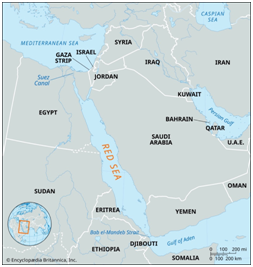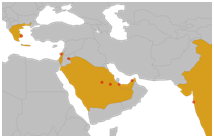Why in the News?
- Houthi (terrorist group) attacks on commercial ships in the Red Sea continue unabated.
- It has once again brought to the fore the vulnerabilities of global supply chains, highlighting the need to revisit alternate routes for global trade.
What’s in Today’s Article?
- About Red Sea (Location, Significance, How the Conflict has Affected India, etc.)
- About IMEC (Purpose, Significance, How It Can be Made Viable, etc.)
About Red Sea:

- The Red Sea is a seawater inlet of the Indian Ocean, lying between Africa and Asia.
- The Red Sea owes its strategic importance for global trade to the Bab el-Mandab Strait which lies between Yemen and Djibouti.
- It is one of the world’s busiest cargo and oil transit points with almost 12% of international merchandise trade passing through it.
- An immediate consequence of the Red Sea conflict has been that major container and oil carriers have been forced to re-route shipments via the Cape of Good Hope.
- The re-routing has led to rising ocean freight, inflated insurance costs, and longer voyage times leading to delays and shortage of products.
- It has also driven up transportation costs. The higher shipping costs will be passed onto consumers in the form of increased commodity prices.
How Has it Affected India?
- India’s trade with European and North African countries flows entirely through the Red Sea route which is almost 24% of its exports and 14% of its imports.
- In the year 2022-23, India’s bilateral trade with Europe and North Africa stood at $189 billion and $15 billion respectively.
- The rising fears among traders have already seen a drop in Indian shipments. As per the Federation of Indian Export Organisations (FIEO), rising threats have prompted Indian exporters to hold back around 25% of their cargo ships transitioning through the Red Sea.
- As global supply chains are battling delayed shipments and rising costs, China is actively projecting China-Europe freight trains, which are part of the Belt and Road Initiative (BRI), as an alternate route.
- The India-Middle East-Europe Economic Corridor (IMEC), which was announced during the G-20 summit in 2023, is another alternative which is not receiving much attention.
About India-Middle East Europe Economic Corridor (IMEC):

- At the sidelines of the G20 Summit held in New Delhi in September 2023, an MoU was signed to develop a rail and shipping corridor connecting India to Europe via the Middle East between India, United States, Saudi Arabia, the United Arab Emirates, France, Germany, Italy, and the European Union.
- The proposed IMEC will involve:
- Rail connectivity,
- Shipping lines,
- High-speed data cables, and
- Energy pipelines.
- These will complement the existing maritime and road networks that will enhance movement of trade and services “to transit to, from, and between India, the UAE, Saudi Arabia, Jordan, Israel, and Europe.”
Significance of IMEC Project:
- IMEC is significant from an infrastructure and connectivity perspective as well as from a geopolitical angle.
- The project involves two separate corridors –
- East Corridor: connects India to the Arabian Gulf, and
- Northern Corridor: connects the Arabian Gulf to Europe.
- According to the MoU, IMEC is “expected to stimulate economic development through enhanced connectivity and economic integration between Asia, the Arabian Gulf, and Europe.”
- The new corridor has other important dimensions, including reliable and secure regional supply chains, better trade accessibility, and trade facilitation.
- In geopolitical terms, IMEC is touted as a counter to China’s Belt & Road Initiative (BRI).
- India, from very early days, had objected to it because the China-Pakistan Economic Corridor, a key component of the BRI, runs through territories claimed by India.
Impact of Israel-Palestine Conflict on IMEC Project:
- With the ongoing Israel-Hamas conflict intensifying, there is a growing realization that the calculations on the kind of diplomatic cooperation that the project of the scale of the IMEC would have warranted as a prerequisite, is far more complicated now.
- The Saudi Arabia – Israel peace deal might not be a possibility in the near future now as mounting anger in the Arab world about the scale of Israel’s offensive in northern Gaza.
- US President Joe Biden’s planned visit in Jordan this week had to be cancelled after an attack on a Gaza hospital.
- A rocket launched near Iraq’s Baghdad International Airport added to a rising number of attacks targeting US forces in the Middle East.
- While the war's direct impact remains regional, the geopolitical consequences reverberate far beyond, with potential consequences for the proposed IMEC corridor.
How Can the IMEC Project be Made Viable?
- Despite such challenges, the economic logic of the corridor holds, which should encourage stakeholders to keep working towards it.
- First, an empirical study on the economic benefits of the corridor needs to be conducted.
- The corridor is estimated to cut the journey time from India to Europe by 40% and slash transit costs by 30%.
- However, there are speculations that multiple handling of cargo and multi-nation transit would increase carriage and compliance costs.
- Therefore, it is critical to quantify the economic advantages of the corridor to attract more stakeholders.
- Secondly, a robust financial framework needs to be in place.
- Since there are no binding financial commitments on any of the signatories of the corridor, investments will have to be attracted from governments, international organisations, and private sector entities.
- Lastly, a comprehensive multi-nation operational framework is needed.
- As the corridor involves facilitating trade across different legal systems, a multi-national framework is necessary.
- A forum for the corridor needs to be constituted to undertake the aforementioned activities.









